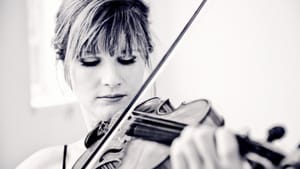Stay in the Loop
BSR publishes on a weekly schedule, with an email newsletter every Wednesday and Thursday morning. There’s no paywall, and subscribing is always free.
A night of musical heroics
Jurowski conducts the Philadelphia Orchestra

Some concerts and recordings have a memorable, even heroic feel about them, as if they capture something of the scope and trajectory of the evolution of Western classical music. In this concert, the masterful conducting of Vladimir Jurowski, the stunning virtuosity and power of the violinist Lisa Batiashvili and the rich sound of the Philadelphia Orchestra came together to stir the senses while evoking the power contained in the breadth and scope of the orchestral repertoire.
Jurowski, who received critical praise for his prior guest conducting with the Orchestra, signaled his intention to bring a certain nobility to the concert with Wagner's prelude to Parsifal, with its lush orchestrations and simplicity of form (Wagner chose to emphasize the opera's moral sentiment rather than introduce its plot as in a traditional "overture"). The passion and redemption inherent in the Parsifal story, with its combined Christian and pagan elements, is heightened in the music by the recurrent string tremolo, which Jurowski brought to a boil.
Wagner's rich sonorities and invocation of mythological heroism provided a frame for Jurowski's rendering of both the Beethoven Violin Concerto and the Prokofiev Symphony.
Beyond musical clichés
Beethoven's Concerto can too easily degenerate into a cliché in the hands of even the best violinists, but Batiashvili took it into the stratosphere of virtuosity, depth and power, rivaling the great Russian violinists Nathan Milstein and David Oistrakh, in her exquisite sound, technical mastery and powerful interpretation. She and Jurowski together brought forth the supremacy and authority of the concerto, which was a transitional leap for Beethoven himself.
Batiashvili was helped by a soul-stirring (if controversial) cadenza in the last movement that was composed by Alfred Schnittke in 1975 and first employed by violinist Gidon Kremer. The cadenza, which is almost a movement in itself, startlingly incorporates references to 20th-Century music Ó la Berg and Shostakovich. It's also almost impossible to play, but Batiashvili came through royally.
Jurowski superbly coordinated the Orchestra with the violinist, and unflinchingly gave the Orchestra equal time rather than relegating it to a secondary accompanying role. In this respect, kudos is due the mainstay timpanist, Don Liuzzi, for his precise percussive punctuations, which Beethoven, in his typical upstart fashion, made a central element of this concerto.
Prokofiev's grief
Prokofiev's Sixth Symphony (his last, written shortly before his death in 1953, mirrors the Parsifal theme of compassion, and even briefly quotes motifs from it). Amid the triumph of Russia's victory in World War II, Prokofiev wanted to emphasize the grief and loss of war, and seemed to search his perhaps compromised memory banks for his own and his fellow composers' emotion-laden material. So while the Sixth Symphony isn't the coherent and thematically-oriented Prokofiev that one expects, it contains earmarks of his own past, and even its dissonances are quite accessible.
Its use of three rather than the standard four symphonic movements harks back to earlier forms, something that Stravinsky attempted shortly before Prokofiev. (Prokofiev may have omitted the rondo movement in order to emphasize the gravity of the piece.) In any case, in this performance, Jurowski mustered the Orchestra's every resource to evoke the complex and deeply felt emotions that Prokofiev struggled to express.
One of Jurowski's strengths as a conductor is his meticulous attention to each section of instruments, whether strings, woodwinds, brass, etc. While many conductors tackle the giant beast of the orchestral totality, a few like Jurowski bring out the special qualities and sonorities of its parts— a valuable skill in elaborating this very complex and ultimately troubling symphony.♦
To read a response, click here.
Jurowski, who received critical praise for his prior guest conducting with the Orchestra, signaled his intention to bring a certain nobility to the concert with Wagner's prelude to Parsifal, with its lush orchestrations and simplicity of form (Wagner chose to emphasize the opera's moral sentiment rather than introduce its plot as in a traditional "overture"). The passion and redemption inherent in the Parsifal story, with its combined Christian and pagan elements, is heightened in the music by the recurrent string tremolo, which Jurowski brought to a boil.
Wagner's rich sonorities and invocation of mythological heroism provided a frame for Jurowski's rendering of both the Beethoven Violin Concerto and the Prokofiev Symphony.
Beyond musical clichés
Beethoven's Concerto can too easily degenerate into a cliché in the hands of even the best violinists, but Batiashvili took it into the stratosphere of virtuosity, depth and power, rivaling the great Russian violinists Nathan Milstein and David Oistrakh, in her exquisite sound, technical mastery and powerful interpretation. She and Jurowski together brought forth the supremacy and authority of the concerto, which was a transitional leap for Beethoven himself.
Batiashvili was helped by a soul-stirring (if controversial) cadenza in the last movement that was composed by Alfred Schnittke in 1975 and first employed by violinist Gidon Kremer. The cadenza, which is almost a movement in itself, startlingly incorporates references to 20th-Century music Ó la Berg and Shostakovich. It's also almost impossible to play, but Batiashvili came through royally.
Jurowski superbly coordinated the Orchestra with the violinist, and unflinchingly gave the Orchestra equal time rather than relegating it to a secondary accompanying role. In this respect, kudos is due the mainstay timpanist, Don Liuzzi, for his precise percussive punctuations, which Beethoven, in his typical upstart fashion, made a central element of this concerto.
Prokofiev's grief
Prokofiev's Sixth Symphony (his last, written shortly before his death in 1953, mirrors the Parsifal theme of compassion, and even briefly quotes motifs from it). Amid the triumph of Russia's victory in World War II, Prokofiev wanted to emphasize the grief and loss of war, and seemed to search his perhaps compromised memory banks for his own and his fellow composers' emotion-laden material. So while the Sixth Symphony isn't the coherent and thematically-oriented Prokofiev that one expects, it contains earmarks of his own past, and even its dissonances are quite accessible.
Its use of three rather than the standard four symphonic movements harks back to earlier forms, something that Stravinsky attempted shortly before Prokofiev. (Prokofiev may have omitted the rondo movement in order to emphasize the gravity of the piece.) In any case, in this performance, Jurowski mustered the Orchestra's every resource to evoke the complex and deeply felt emotions that Prokofiev struggled to express.
One of Jurowski's strengths as a conductor is his meticulous attention to each section of instruments, whether strings, woodwinds, brass, etc. While many conductors tackle the giant beast of the orchestral totality, a few like Jurowski bring out the special qualities and sonorities of its parts— a valuable skill in elaborating this very complex and ultimately troubling symphony.♦
To read a response, click here.
What, When, Where
Philadelphia Orchestra: Wagner, Prelude to Parsifal; Beethoven, Violin Concerto in D Minor, Op. 61; Prokofiev: Symphony No. 6 in E-flat minor, Op. 11. Lisa Batiashvili, violin; Vladimir Jurowski, conductor. February 17-19, 2011 at Verizon Hall, Kimmel Center. (215) 893-1999 or www.philorch.org.
Sign up for our newsletter
All of the week's new articles, all in one place. Sign up for the free weekly BSR newsletters, and don't miss a conversation.

 Victor L. Schermer
Victor L. Schermer